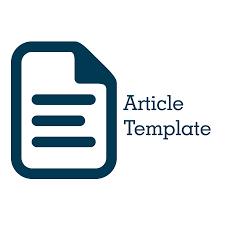Penerapan Metode Multisensori untuk Kemampuan Membaca Permulaan pada Siswa Kelas I di SD X Bangkalan
Abstract
Keywords
Full Text:
PDFReferences
Acheaw, M. O. & Larson, A. G. (2014). Reading habits among students and its effect on academic performance: a study of students of koforidua polytchnic. Library Philoshophy and Practice (E-Journal).
Aerila, J. A., Keskitalo, A., & Urmson, K. (2016). A-B-C-Shaping alphabets with methods of outdoor and multisensory learning. Journal of Early Childhood Education Research. 5 (1), 19-43.
Ardini, P. P. & Handini, M. C. (2017). The influence of instructional method, visual spatial intelligence, and school readiness on early reading abilities. Journal of Scientific Research & Reports. 17 (4), 1-22.
Akubuilo, F. (2015). Reading readiness deficiency in children: Causes and ways of improvement. Journal of Education and Practice. 6 (24), 38-43.
Brown, C. S. (2014). Language and literacy development in the early years: Foundational skills that support emergent readers. The Language and Literacy Spectrum. 24 (), 35-49.
BSNP. (2006). Standar kompetensi dan kompetensi dasar SD/MI. Diunduh pada 19 Januari 2018, dari http://educloud.fkip.unila.ac.id/index.php?dir=Ilmu%20Pendidikan/Pendidikan%20Guru%20Sekolah%20Dasar/&file=Standar%20Isi%20SD.pdf
Caroll, J. (2010). Closing the achievement gaps: Early reading success and connecticut’s economic future. Harford: Connecticut Association for Human Services.
Capellini, Caesar, & Germano. (2015). Early identification of reading problems: Preliminary study with students of 1st grade. International Conference on New Horizons in Education. 1351-1355.
Centre for Education Statistics and Evaluation. (2017). Effective reading instruction in the early years of school. Diunduh pada 1 Desember 2017, dari http://www.fivefromfive.org.au/wp-content/uploads/2017/04/Effective_Reading_Instruction.pdf
Center for Public Education. (2015). Learning to read, reading to learn. Diunduh pada 1 Desember 2017, dari https://www.nsba.org/sites/default/files/reports/NSBA_CPE_Early_Literacy_Layout_2015.pdf
Chow, B. W. Y., Chang, C. M., & Burgess, S. (2008). Phonological Processing Skills and Early Reading Abilities in Hong Kong Chinese Kindergarteners Learning to Read English as a Second Language. Journal of Educational Psychology. 97 (1), 81-87.
Dewi, S. U. S. (2015). Pengaruh metode multisensori dalam meningkatkan kemampuan membaca permulaan pada siswa kelas awal sekolah dasar. 3 (1), 1-13.
Falzon, R., Calleja, C., & Muscat, C. (2011). Structured multisensory techniques in reading and learning patterns - some considerations.
Feister, L. (2010). Early warning: Why reading by the end of third grade matters. Baltimore: Annie E. Casey Foundation.
Feretti, G., Mazzotti, S., & Brizzolara. (2008). Visual scanning and reading ability in normal and dyslexic children. Behavioral Neurology. 87-92.
Fitzpatrick, M. (2010). Teaching your baby to read. Diunduh pada 1 Desember 2017, dari http://www.brillkids.com/media/ebooks/ebook-teaching-your-baby-to-read.pdf
Furlong, N., Lovelace, E., & Lovelace, K. (2000). Research methods and statistics: An Integrated Approach. Florida: Harcourt Brace & Company.
Gumono. (2014). Profil kemampuan membaca peserta didik sekolah dasar di provinsi bengkulu. Lentera Pendidikan. 7 (2), 201-211.
Hebert, W. (2015). 10 Benefits of reading: Why you should read every day. Diunduh pada 1 Desember 2015, dari https://www.lifehack.org/articles/lifestyle/10-benefits-reading-why-you-should-read-everyday.html?hootPostID=015661773a0770b9e7687cf19cdcec38
Hergenhahn, B.R dan Olson, Matthew H. (2009). Theories of Learning, Edisi Ketujuh. Jakarta : Kencana.
Hlalethwa, B. D. (2013). Reading difficulties experienced by learners in the foundation phase in inclusive schools in makapanstad. Diunduh pada 1 Desember 2017, dari https://elmirmohammedmemorypsy.files.wordpress.com/2017/11/reading-difficulties-experienced-by-learners.pdf
Lei, P. L., Lin, S. S. J., & Sun, C. (2013). Effect of reading ability and internet experience on keyword-bases image search. Educational Technology & Society. 16 (2), 151-162.
Lerner, J. W. (2003). Learning disabilities: theories, diagnosis, and teaching strategies (9th ed). Boston: Houghton Mifflin Company.
Loh, J. K. K. (2009). Teacher modeling: Its impact on an extensive reading program. Reading in a Foreign Language. 21 (2), 93-118.
Lynch, J. (2007). Learning about literacy: Social factors and reading acquisition. Encyclopedia of Language and Literacy Development. London: Canadian Language and Literacy Research Network.
Musen, L. (2010). Early Reading Proficiency. Leading Indicators for Education. New York: Annenberg Institute for School Reform.
Nourbakhsh, S., Mansor, M., Baba, M., & Madon, Z. (2013). The effect of multisensory method and cognitive skills training on perceptual performance and reading ability among dyslexic students in tehran-iran. International Journal of Psychological Studies. 5 (2), 92-99.
Obaid, M. A. S. (2013). The impact of using multi-sensory approach for teaching students with learning disabilities. Journal of International Education Research. 9 (2), 75-82.
Professional Development Service for Teachers. (2012). The reading process. Diunduh pada 1 Desember 2017, dari http://www.pdst.ie/sites/default/files/Reading%20Booklet%20-%20to%20circulate.pdf
Rahmawati. (2017). Strategi pembelajaran membaca dan menulis permulaan melalui media kata bergambar. Jurnal SAP. 1 (3), 259 -270.
Riskiana. (2016). Analisis kesulitan membaca permulaan siswa kelas 1 SDN Bangunrejo 2 Kricak Tegalrejo Yogyakarta. Diunduh pada 1 Desember 2017, dari http://eprints.uny.ac.id/40935/1/Rizkiana.pdf
Rome, P. D. & Osman, J. S. (1979). Procedurs for helping the dyslexic child: Remediation. Pediatric Annals. 8 (11), 57-83.
Ruscoe, K. A. (2003). Cool tools informal reading assesment. Florida: Department of Education.
Santrock, J. W. (2002). Live-span development. Jakarta: Penerbit Erlangga.
Shams, L. & Seitz, A. R. (2008). Benefits of multisensory learning. Trends in Cognitive Science. 12 (11), 411-417.
Sugiharto, H. (2016). Metode VAKT terhadap kemampuan membaca siswa kesulitan belajar. Jurnal Pendidikan Khusus.
The Centre for Literacy in Primary Education. (2016). Reading and writing scales. Diunduh 1 Desember 2017, dari https://ukla.org/downloads/CLPE_READING_SCALE.pdf
The International Dyslexia Association. (2001). Clinical studies of multisensory structured language education for students with dyslexia and related disorders. International Multisensory Structured Language Education Council (IMSLEC).
USAID. (2004). Pembelajaran literasi kelas awal SD/MI di LPTK. Diunduh pada 1 Desember 2017, dari http://repository.stkipgetsempena.ac.id/bitstream/549/1/Pembelajaran_Literasi_dikelas_Awal_di_LPTK.pdf
Wen, H. (2013). Chomsky’s language development theories: Rescuing parents out of dilemma. International Journal of Learning & Development. 3 (3), 148-153.
Yildirim, K. & Ates, S. (2012). Silent and oral reading fluency: which one is the best predictor or reading comprehension of turkish elementary students ?. International Journal on New Trends in Education and Their Implications. 3 (4). 79-91.
Zhou, M. & Brown, D. (2015). Educational learning theories. Georgia: Galilio Open Learning Materials.
DOI: https://doi.org/10.32528/ins.v16i2.2117
Refbacks
- There are currently no refbacks.
Copyright (c) 2021 Insight : Jurnal Pemikiran dan Penelitian Psikologi

This work is licensed under a Creative Commons Attribution 4.0 International License.
View My Stats


.jpg)







